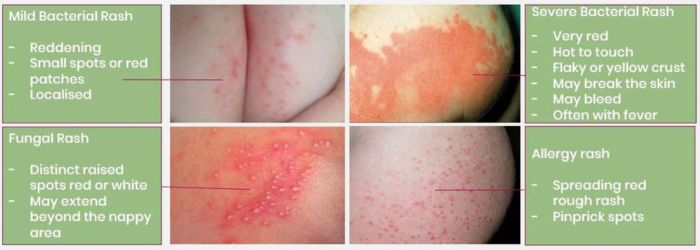What Is Diaper Rash?
Diaper rash or diaper dermatitis is a common skin irritation that occurs in the diaper-covered region of a baby's skin. It is often caused by prolonged exposure to moisture, friction, and the chemicals present in urine and feces. Diaper rash can make your baby’s skin red, very tender, and flaky.
What does diaper rash look like?

Diaper rash can make your baby’s skin red, very tender, and flaky, generally pink or red patches in the diaper area. but the folds of the groin will usually look normal. With proper treatment, it will usually clear up within three or four days. However, if the diaper rash doesn’t noticeably improve within a couple of days, or, if it gets worse, call your baby’s healthcare provider for guidance.
What are the symptoms of diaper rash?
Symptoms of diaper rash include inflamed skin in the diaper area ( buttocks, thighs and genitals), itchy, tender skin, sores in the diaper area and discomfort, fussiness or crying, especially during diaper changes.
Diaper rash is a common skin condition that affects the diaper area of babies. It can cause redness, irritation, itching, and sometimes sores or blisters. Some of the symptoms of diaper rash are:
- Inflamed skin in the buttocks, thighs, and genitals.
- Itchy, tender skin in the diaper area.
- Sores or blisters in the diaper area.
- Discomfort, fussiness, or crying, especially during diaper changes.
Diaper rash can be caused by various factors, such as wet or soiled diapers, chafing, skin sensitivity, yeast or bacterial infection, or allergic reaction. To prevent diaper rash, it is important to change diapers frequently, keep the skin clean and dry, use a barrier cream or ointment, and avoid irritants.
What causes diaper rash?
Baby diaper rash is a common skin condition that affects babies and toddlers. It can be caused by different factors, such as wet or soiled diapers, chafing, new products, infections, or food changes.
Diaper rash can make your baby’s skin red, tender, and flaky. It can also cause discomfort, itching, or pain. Even with frequent diaper changes, diaper rash can still happen. The most common cause of diaper rash is skin irritation resulting from
- Being allergic to the materials of the diaper.
- Wet or soiled diapers that aren't changed often enough.
- Prolonged exposure to moisture, friction, and the chemicals present in urine and feces.
- Diarrhea can increase the risks of diaper rash as it brings the skin in contact with loose feces.
- Bacterial, yeast infection.
- Diaper or clothing that tight-fitting can cause chafing or rubbing.
With proper treatment, it will usually clear up within three or four days. However, if the diaper rash doesn’t noticeably improve within a couple of days, or, if it gets worse, call your baby’s healthcare provider for guidance.
Types of diaper rash

Diaper rash is common in babies, as anyone who wears a diaper regularly can develop it. Diaper rash can be caused by an allergy, irritation, bacteria, or fungus. Diaper rash types include:
1. Irritant dermatitis: Irritant diaper rash, or diaper dermatitis, is the most common type of diaper rash. It occurs when your baby’s diaper area has too much moisture and/or prolonged contact with pee (urine) and poop (stool).
2. Candida dermatitis: An overgrowth of a type of fungus called candida can cause yeast diaper rashes. Candida is found naturally in your baby’s digestive tract.
3. Bacterial dermatitis: Rarely, certain types of bacteria, such as staph or strep, can cause diaper rash. Another name for this type is impetigo.
4. Allergic dermatitis: If your baby has sensitive skin, they may have an allergic reaction to ingredients in certain diapers, wipes and/or diaper creams.
Does diaper rash go away?
Mild diaper rashes typically go away with home treatment within three to four days. More severe cases may require treatment with antibiotics or antifungals. With these medications, your baby’s diaper rash may take a week or longer to clear up.
What is the best treatment for diaper rash?
The best way to treat diaper rash is to keep your baby's skin dry and clean and change their diaper often. You can also use over-the-counter creams or ointments that contain zinc oxide or petrolatum to protect the skin and help it heal.
If a rash persists even with prescription products, your doctor or other health care professional may recommend that your baby see a specialist in skin conditions (dermatologist).
If the rash is severe, unusual, or doesn't improve with home care, you should see a doctor or other health care professional for advice. They may prescribe a stronger cream or diagnose the rash as another condition.
1.Keep it clean: Clean the diaper area gently with mild soap and water during each diaper change. Pat the area dry; avoid rubbing.
2. Apply diaper cream: Use a diaper rash cream or ointment with zinc oxide to soothe and protect the irritated skin. Petroleum jelly can also be helpful.
3. Avoid irritants: Steer clear of using baby wipes or products containing alcohol, fragrances, or harsh chemicals during the rash. Instead, use a soft cloth with water.
4. Loose-fitting diapers: Opt for diapers that are not too tight, as snug diapers can trap moisture and exacerbate the rash.
5. Give time for healing: If possible, provide diaper-free time to allow the affected area to air out and speed up the healing process.
Diaper rash is quite common, and can happen to any baby. The skin condition can make your baby’s diaper area red, tender, and flaky. Changing your baby’s diaper regularly and immediately after it’s soiled can help prevent diaper rash. If your baby’s diaper rash persists, consult her healthcare provider.
How to prevent diaper rash?
Diaper rash is a common condition that typically forms when the sensitive skin around your baby’s diaper area is in contact with urine or stool for prolonged time. Protecting your baby against diaper rash means regularly changing his diapers. Some tips to prevent diaper rash are:
1. Change diapers frequently:
Change your baby's diaper as soon as it's wet or soiled. Ensure you change your baby's diapers regularly, ideally every 2-3 hours, or as soon as they are wet or soiled.
2. Choose the right diapers:
Use diapers that are breathable and designed to wick moisture away from the baby's skin. Consider using diapers without added fragrances or dyes. Make sure the diaper is not too tight or too loose. It should fit perfectly but allow some air circulation.
3. Clean thoroughly:
Pat your baby's skin dry with a clean towel or let it air dry before putting on a new diaper. Gently clean your baby's diaper area during each diaper change using mild wipes or a soft cloth. Avoid rubbing or scrubbing the skin.
4. Avoid irritants:
Avoid using products that may irritate your baby's skin, such as scented wipes, lotions, powders, or oils. Avoid wipes with alcohol or fragrances, as they may irritate the skin. Use gentle wipes or a soft cloth with water to clean your baby's diaper area.
5. Allow diaper-free time:
Give your baby some diaper-free time during the day to let the skin breathe and stay dry. Lay them on a waterproof pad or a towel to minimize mess. Give your baby some diaper-free time every day to let the skin breathe.
6. Use a barrier cream:
Apply a thin layer of a diaper rash cream or ointment containing zinc oxide to create a protective barrier between the baby's skin and moisture.
7. Watch for allergic reaction:
If your baby is eating solid foods, introduce new foods one at a time and watch for any signs of allergic reaction or increased stool frequency
Make sure to change your baby’s diaper as soon as it's wet or soiled, keep the diaper area clean, and use a diaper cream. It’s also a prefect decision to wear your child a highly absorbent diaper and to make sure that it isn’t too tight and doesn't chafe.
The best treatment for diaper rash is to always keep your baby's skin clean and dry as much long as possible. Depending on the severity of diaper rash, it might take several days to improve. If the diaper rash hasn't improved after a few days of treatment at home or come back again and again, talk with your doctor or other health care professional(dermatologist).. You may need prescription medicine to treat diaper rash. Or the rash may have another cause.

